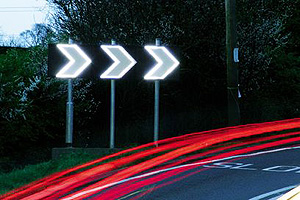Top 10 most dangerous roads in the UK.
Top 10 Most Dangerous Roads in the UK
Why this page?
So why talk about dangerous roads in a site dedicated to information about car maintenance. Mostly to fill the site out with ancilliary information that you might find useful. I try to write the site to fit my own random thought process and this is one of the topics that comes up in discussion with friends from time to time.
So which roads are safer? Motorways, dual carriageways or single lane A roads? A question that many of you have probably pondered; the answer however may surprise you.
You'd think that dual carriage ways or motorways would carry the highest risk of an jury or fatality due to the level of traffic using them, but, in actual fact, it's the A roads that account for some of the UK's most dangerous stretches. Car insurance premiums rise ever year as a result of the increasing cost of claim settlement, acerbated by the rising compensation mentality in the UK; making car insurance comparison more important than ever.
Scotland is thought to have some of the most dangerous highways due to their remoteness in the majority of cases, coupled with steep falls and severe bends encompassed by dry-stone walls (a general recipe for an accident on many of the most dangerous roads around the UK). So without further ado here are the current (as published in surveys by the Road Safety Foundation and EuroRap) top 10 most dangerous A roads in the UK as surveyed between 2005-2007 (Ranked by number of accidents per km for ease of display):
| Road No. | Description | Road Length (km) | No. of Serious/Fatal Collisions | Junctions | Involving Pedestrians/Cyclists | Number of Accidents Per km |
|---|---|---|---|---|---|---|
| A537 | Macclesfield - Buxton | 12 | 27 | 22 | 4 | 2.25 |
| A255 | Margate - Ramsgate | 8 | 18 | 22 | 61 | 2.25 |
| A62 | M62 J27 - A6110 | 5 | 9 | 44 | 0 | 1.80 |
| A621 | A619 - Totley | 9 | 12 | 42 | 0 | 1.33 |
| A675 | M65 J3 - Bolton | 13 | 17 | 18 | 6 | 1.31 |
| A5004 | Whaley Bridge - Buxton | 12 | 15 | 20 | 0 | 1.25 |
| A285 | A27 - Petworth | 19 | 18 | 22 | 6 | 0.95 |
| A5012 | A515 - A6 | 15 | 14 | 21 | 14 | 0.93 |
| A54 | Congleton - Buxton | 24 | 20 | 15 | 20 | 0.83 |
| A686 | Penrith - Haydon Bridge | 58 | 35 | 14 | 6 | 0.60 |
Speed certainly plays its part in some accidents and the design and layout of the roads and roadside furniture (crash barriers, lamp posts etc) has a huge influence too, but it is worth remembering that one-third of serious collisions occur at junctions, caused for the most part by driver error. Something else to think about - roads can be more dangerous in one direction than the other. The road at the number one spot, is also known as the Cat & Fiddle because of the popular pub at the top of it. Going up the road isn't a problem. Coming down you're faced with several instances of humped brows of hills followed by tight, decreasing-radius corners. Without local knowledge, drivers don't know and find it hard to forsee these problems and very often the crashes on that road happen as the suspension unloads on the vehicle as it crests the brow of the hill, leaving little time or mechanical grip to slow down and turn before the corner.
How to minimise the risk then? Use your eyes - read the road - don't drive beyond your capability. Sticking to posted speed limits can also minimise risk but pay particular attention to 'slow' signs and warnings of sharp bends (the big chevron arrows); another hazard to the driver.  As a side note, the picture on the right here shows a new road sign being tried out in some parts of the country. It's a tight corner chevron, but equipped with radar. If it detects you're approaching too quickly, the arrows light up with white LEDs in sequence - a visual enhancement to alert you of the approaching tight bend.
As a side note, the picture on the right here shows a new road sign being tried out in some parts of the country. It's a tight corner chevron, but equipped with radar. If it detects you're approaching too quickly, the arrows light up with white LEDs in sequence - a visual enhancement to alert you of the approaching tight bend.
Photo credit: Auto Express magazine.
Currently, around £18bn is spent each year in relation to road crashes, mostly due to the costs of emergency services and health care. A substantial saving and reduction in the number of accidents could easily be achieved by better signage/road markings and resurfacing (including anti-skid measures) on the worst affected stretches of road. Case in point: covering the tops of manhole covers with an anti-skid grit coating could reduce the number of motorcycle accidents on roundabouts, especially where diesel has been spilled (which it has a tendency to do when trucks corner roundabouts will full tanks - the diesel spills out.)
If you find yourself making a journey on one of the roads listed above follow these simple rules; drive carefully, treat every other road user as a possible danger and double-check your mirrors and blindspots several times before making a manoeuvre or exiting a junction.
